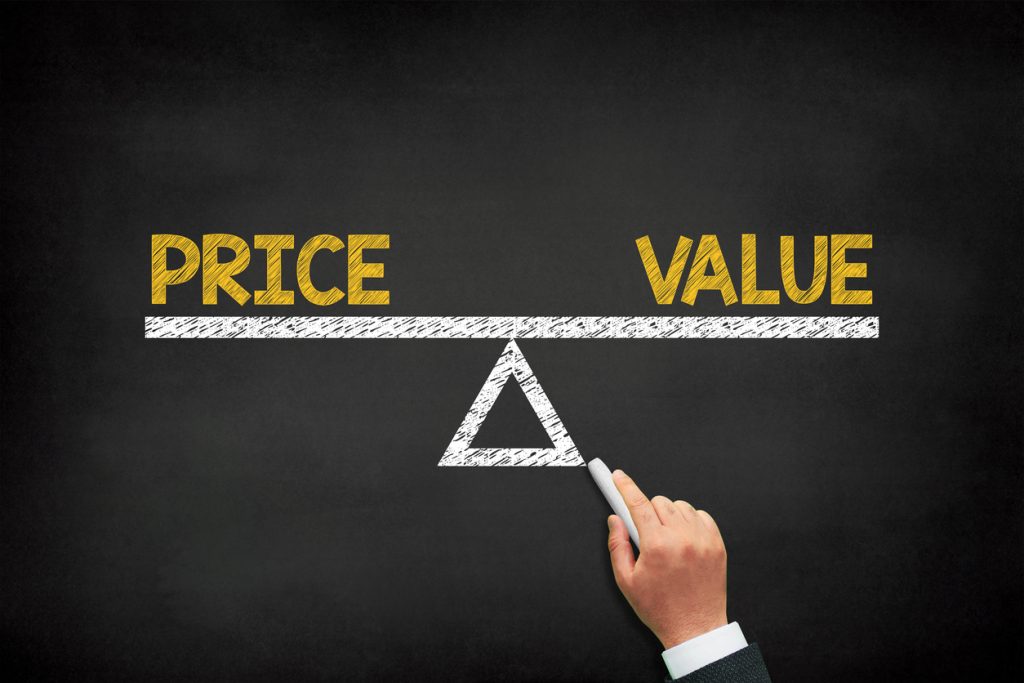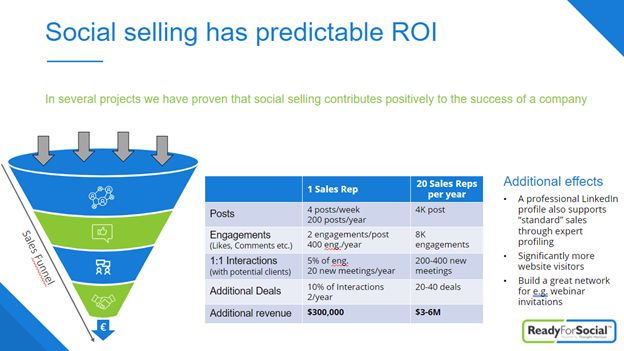
How to unlock the power of digital marketing through social selling – the business case
One of a kind: ReadyForSocial™ ist das einzige All-in-One Programm, mit dem Ihr Vertriebsteam das volle Potenzial sozialer Medien ausschöpfen kann.
This is the 4th part of our mini-series “Increase ROI with social selling” for enterprise rainmakers. The content is based on our experience with implementing and managing successful social selling programs since 2014 in Fortune 500, DAX, and mid-sized companies in the US and Europe. Our longest-running social selling program has been in place since 2018, and our largest program has over 1,000 social sellers at a single company.
It’s old news that digital marketing is a powerful tool to reach customers innovatively in today’s business environment. However, many marketers still struggle to make the case for investing in social selling initiatives, especially at companies in more traditional industries like manufacturing.
Are you one of them? If so, don’t worry. This article will explore the various benefits of enterprise social selling programs and teach you how to build the business case for investing in this critical area of digital marketing. We’ll help you take advantage of the potential of using social media for sales by unlocking the power of social selling.

1. Why your business needs a social selling program: Understand the benefits of social selling for your brand.
Social selling offers many benefits for businesses looking to strengthen their (digital) marketing efforts. By engaging with potential customers directly on social media channels, companies can increase brand awareness and generate qualified leads that can be nurtured over time into sales opportunities. Additionally, social selling provides an excellent opportunity to demonstrate thought leadership in your industry while showcasing your products or services more personally than other forms of advertising or marketing. Consider the social media profiles of your salespeople at your 24-hour trade show booth. (P.S.: We’ve borrowed this idea from Mary Keough at Gorilla76 and The Manufacturing Marketer Podcast).
2. What does social selling cost?
In our last blog post, we explored the elements and cost of an enterprise social selling program in detail. You can catch up if you’ve missed it. As a quick recap, you will be looking at approximately $100–$200 per salesperson participating in the program per month. This number covers all program elements (content, distribution platform or social selling tool with analytics, and program management). It also contains your internal resources and payouts to your suppliers and vendors. Let’s look at the upside of social selling next.

3. Building the business case for enterprise social selling: Quantify the benefits.
Creating measurable objectives that demonstrate a return on your investment in social selling is essential for success. Every business may have slightly different goals, but typically all measure success using the same set of Key Performance Indicators (KPIs) for their social selling initiatives. Although many organizations fund their efforts in socially-driven selling with their marketing budgets, we suggest viewing it as a broader combination of marketing and sales—and quantifying success according to the associated metrics:
- Awareness: This is a relatively simple calculation, as it requires you to measure the reach of your posts and how many times they have been viewed on different platforms. You can even put a price tag on it by referencing similar marketing efforts on LinkedIn or through the cost of ad space purchases via Google Ads. Assessing this kind of data for an entire team (e.g., your sales force) can be daunting, but most social selling solutions have analytics features that make it easier to compile data like this. As your sales reps expand and strengthen their relationships with current and potential customers on social media, the value of your social impressions is increasing due to its connection to an incredibly relevant audience: your sales team’s network.
- Engagement and conversion: Interactions like likes, shares, and comments are valuable as they let you know what interests your audience. Furthermore, these actions can be the beginning of or a relevant touchpoint on your customers’ buyer journey. This journey can be entirely digital or blended with events such as web conferences or physical gatherings. It can also simply be a conversation with one of your sales reps.

- New deals or deal value: Eventually, social selling will contribute to your sales team closing new business. The way to close the deal can look different every time since there is a range of possible social selling contributions. These can range from deals that start with a single post or a conversation with a social contact who has not been interested in your product or service before to situations in which customers have been nurtured across different marketing channels, including social media. Are you wondering how to assess the attribution that social selling has had to specific deals? This part isn’t always straightforward, but it is possible. When you consider social selling’s contribution to new business, give yourself a range. Assuming your range was 10%–20%, let’s evaluate your case and analyze the result. Would social selling still make economic sense?
4. Social selling is a marathon, not a sprint: Give yourself time.
It’s crucial to remember not to be too precise with your projections at the beginning. Instead, choose a margin that feels right. Success in social selling doesn’t take place in an instant. It typically takes three to six months before it’s fully ramped up and you start seeing the first results. So give yourself and your sales team sufficient time to work some social magic, track the progress, and modify strategies as necessary.
5. Let’s talk numbers: what can you expect?
Let’s assume you have a group of 30 enthusiastic sellers to start your social selling program with. If approximately 60% of them (around 20 salespeople) stick with the program and share four posts per week, each person posts 200 times a year. Our rule of thumb is that you should see roughly two relevant engagements per post. We define relevant engagements as engagements by existing or prospective customers. This strategy promises you around 400 relevant engagements per year per social seller. Imagine that approximately 5% of these engagements turn into conversations with potential clients and 10% of these conversations into new deals. Depending on your deal value, this can be significant additional revenue for your company (as we’ve illustrated in the graphic below).

Take action now to unlock the power of digital marketing through social selling!
After unpacking some critical considerations regarding building a business case for investing in enterprise social selling, you have all the information you need to set your business up for social selling success. Remember our input on key factors such as measurement options and tactics used to evaluate success. Contact us if you’re interested in a more personal conversation about your business, measurements, or expected results. We are happy to set up a personal call and help one-on-one.
Image credits: iStock: triloks, PeopleImages, marrio31, Makhbubakhon Ismatova, ReadyForSocial by Thought Horizon

